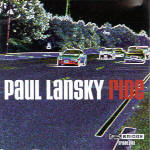When you think of a composer working in the electronic music studio at Princeton University, it just doesn’t swing somehow: Princeton never has been the center for Deep Elvis. But Paul Lansky is the stereotype-defying composer of intelligent, urbane, and downright attractive computer music. While listening to Ride, his newest collection, something uncharacteristic happens: the toe begins to tap along. Smart went hip . . . mostly. The first piece, Idle Chatter Junior, creates a sound world that is like Laurie Anderson at her uptown-cocktail-party best. There are voices in this composition but their words have been processed past the point of being recognizable–the idlest of idle chatter. The music pulses and grooves with great motion, but due to lack of contrast this very specific, very creative sound quickly wears out its welcome.
Ride, the title track, is orchestral in scope. The music functions like a sonic car cruising different landscapes. It works like the soundtrack to the opening shot from Touch of Evil (Orson Welles’ original version) played in slow motion; it’s both heady and creepy. The most conceptually interesting piece on the disc is Heavy Set, where a computer riffs over traditional chord changes. Though certain parameters were set, the machine produces a “random” stream, a true improvisation. The result is biting, like an impossible Ligeti Étude (they do exist!) played over the soundtrack to Twin Peaks. Sadly, it too gets old quickly, its relentlessly repetitive ideas becoming a tiring consistency.
Lansky dreams of a day when the use of a computer to make music is not perceived as an oddity but is as accepted as any other “normal” method for composition and performance. Although the power and non-academic appeal of these pieces makes them less intimidating or alienating than many existing computer-generated works, only when the compositions are as elegant as their conceptual design and electronic execution will that day come.
































